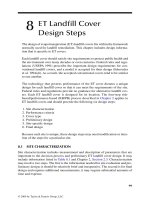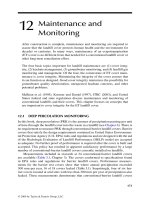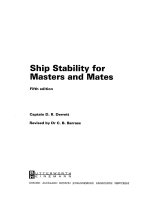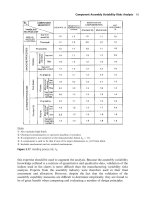Ship Stability for Masters and Mates 5 Episode 1 potx
Bạn đang xem bản rút gọn của tài liệu. Xem và tải ngay bản đầy đủ của tài liệu tại đây (458.29 KB, 28 trang )
Ship Stability for Masters
and Mates
Ship Stability for
Masters and Mates
Fifth edition
Captain D. R. Derrett
Revised by Dr C. B. Barrass
OXFORD AUCKLAND BOSTON JOHANNESBURG MELBOURNE NEW DELHI
Butterworth-Heinemann
Linacre House, Jordan Hill, Oxford OX2 8DP
225 Wildwood Avenue, Woburn, MA 01801-2041
A division of Reed Educational and Professional Publishing Ltd
First published by Stanford Maritime Ltd 1964
Third edition (metric) 1972
Reprinted 1973, 1975, 1977, 1979, 1982
Fourth edition 1984
Reprinted 1985
First published by Reed Educational and Professional Publishing Ltd 1990
Reprinted 1990 (twice), 1991, 1993, 1997, 1998, 1999
Fifth edition 1999
Reprinted 2000 (twice), 2001
# D. R. Derrett 1984, 1990, 1999 and Reed Educational
and Professional Publishing Ltd 1999
All rights reserved. No part of this publication
may be reproduced in any material form (including
photocopying or storing in any medium by electronic
means and whether or not transiently or incidentally
to some other use of this publication) without the
written permission of the copyright holder except
in accordance with the provisions of the Copyright,
Designs and Patents Act 1988 or under the terms of a
licence issued by the Copyright Licensing Agency Ltd,
90 Tottenham Court Road, London, England W1P 0LP.
Applications for the copyright holder's written permission
to reproduce any part of this publication should be addressed
to the publishers
British Library Cataloguing in Publication Data
A catalogue record for this book is available from the British Library
Library of Congress Cataloguing in Publicaion Data
A catalogue record for this book is available from the Library of Congress
ISBN 0 7506 4101 0
Typesetting and artwork creation by David Gregson Associates, Beccles, Suffolk
Printed and bound in Great Britain by Biddles, Guildford, Surrey
A member of the Reed Elsevier plc group
Contents
Preface vii
Introduction ix
Ship types and general characteristics xi
1 Forces and moments 1
2 Centroids and the centre of gravity 9
3 Density and speci®c gravity 19
4 Laws of ¯otation 22
5 Effect of density on draft and displacement 33
6 Transverse statical stability 43
7 Effect of free surface of liquids on stability 50
8 TPC and displacement curves 55
9 Form coef®cients 61
10 Simpson's Rules for areas and centroids 68
11 Final KG 94
12 Calculating KB, BM and metacentric diagrams 99
13 List 114
14 Moments of statical stability 124
15 Trim 133
16 Stability and hydrostatic curves 162
17 Increase in draft due to list 179
18 Water pressure 184
19 Combined list and trim 188
20 Calculating the effect of free surface of liquids (FSE) 192
21 Bilging and permeability 204
22 Dynamical stability 218
23 Effect of beam and freeboard on stability 224
24 Angle of loll 227
25 True mean draft 233
26 The inclining experiment 238
27 Effect of trim on tank soundings 243
28 Drydocking and grounding 246
29 Second moments of areas 256
30 Liquid pressure and thrust. Centres of pressure 266
31 Ship squat 278
32 Heel due to turning 287
33 Unresisted rolling in still water 290
34 List due to bilging side compartments 296
35 The Deadweight Scale 302
36 Interaction 305
37 Effect of change of density on draft and trim 315
38 List with zero metacentric height 319
39 The Trim and Stability book 322
40 Bending of beams 325
41 Bending of ships 340
42 Strength curves for ships 346
43 Bending and shear stresses 356
44 Simpli®ed stability information 372
Appendix I Standard abbreviations and symbols 378
Appendix II Summary of stability formulae 380
Appendix III Conversion tables 387
Appendix IV Extracts from the M.S. (Load Lines) Rules, 1968 388
Appendix V Department of Transport Syllabuses (Revised April
1995) 395
Appendix VI Specimen examination papers 401
Appendix VII Revision one-liners 429
Appendix VIII How to pass exams in Maritime Studies 432
Appendix IX Draft Surveys 434
Answers to exercises 437
Index 443
vi Contents
Example 1
Whilst moving an object one man pulls on it with a force of 200 Newtons, and
another pushes in the same direction with a force of 300 Newtons. Find the
resultant force propelling the object.
Component forces 300 N A 200 N
The resultant force is obviously 500 Newtons, the sum of the two forces, and
acts in the direction of each of the component forces.
Resultant force 500 N A or A 500 N
Example 2
A force of 5 Newtons is applied towards a point whilst a force of 2 Newtons is
applied at the same point but in the opposite direction. Find the resultant force.
Component forces 5 N A 2 N
Since the forces are applied in opposite directions, the magnitude of the
resultant is the difference of the two forces and acts in the direction of the 5 N
force.
Resultant force 3 N A or A3N
(b) Resolving two forces which do not act in the same straight line
When the two forces do not act in the same straight line, their resultant can
be found by completing a parallelogram of forces.
Example 1
A force of 3 Newtons and a force of 5 N act towards a point at an angle of 120
degrees to each other. Find the direction and magnitude of the resultant.
Ans.
Resultant 4.36 N at 36
34
1
2
H
to the 5 N force.
Note. Notice that each of the component forces and the resultant all act
towards the point A.
2 Ship Stability for Masters and Mates
Fig. 1.1
<>
>>
EE
E
E
E
E
))
)
)
Example 2
A ship steams due east for an hour at 9 knots through a current which sets 120
degrees (T) at 3 knots. Find the course and distance made good.
The ship's force would propel her from A to B in one hour and the current
would propel her from A to C in one hour. The resultant is AD, 0X97
1
2
 11X6
miles and this will represent the course and distance made good in one hour.
Note. In the above example both of the component forces and the resultant
force all act away from the point A.
Example 3
A force of 3 N acts downwards towards a point whilst another force of 5 N acts
away from the point to the right as shown in Figure 1.3. Find the resultant.
In this example one force is acting towards the point and the second force is
acting away from the point. Before completing the parallelogram, substitute
either a force of 3 N acting away from the point for the force of 3 N towards
the point as shown in Figure 1.4, or a force of 5 N towards the point for the
Forces and moments 3
Fig. 1.2
Fig. 1.3
Fig. 1.4
force of 5 N away from the point as shown in Figure 1.5. In this way both of
the forces act either towards or away from the point. The magnitude and
direction of the resultant is the same whichever substitution is made; i.e. 5.83 N
at an angle of 59
to the vertical.
(c) Resolving two forces which act in parallel directions
When two forces act in parallel directions, their combined effect can be
represented by one force whose magnitude is equal to the algebraic sum of
the two component forces, and which will act through a point about which
their moments are equal.
The following two examples may help to make this clear.
Example 1
In Figure 1.6 the parallel forces W and P are acting upwards through A and B
respectively. Let W be greater than P. Their resultant, (W P), acts upwards
through the point C such that P Ây W Âx. Since W is greater than P, the
point C will be nearer to B than to A.
Example 2
In Figure 1.7 the parallel forces W and P act in opposite directions through A
and B respectively. If W is again greater than P, their resultant, (W ÀP), acts
through point C on AB produced such that P Ây W Âx.
4 Ship Stability for Masters and Mates
Fig. 1.5
Fig. 1.6
Fig. 1.7
Moments of Forces
The moment of a force is a measure of the turning effect of the force about a
point. The turning effect will depend upon the following:
(a) The magnitude of the force, and
(b) The length of the lever upon which the force acts, the lever being the
perpendicular distance between the line of action of the force and the
point about which the moment is being taken.
The magnitude of the moment is the product of the force and the length
of the lever. Thus, if the force is measured in Newtons and the length of the
lever in metres, the moment found will be expressed in Newton-metres
(Nm).
Resultant moment. When two or more forces are acting about a point
their combined effect can be represented by one imagin ary moment called
the 'Resultant Moment'. The process of ®nding the resultant moment is
referred to as the 'Resolution of the Component Moments'.
Resolution of moments. To calculate the resultant moment about a point,
®nd the sum of the moments to produce rotation in a clockwise direction
about the point, and the sum of the moments to produce rotation in an
anti-clockwise direction. Take the lesser of these two moments from the
greater and the difference will be the magnitude of the resultant. The
direction in which it acts will be that of the greater of the two component
moments.
Example 1
A capstan consists of a drum 2 metres in diameter around which a rope is
wound, and four levers at right angles to each other, each being 2 metres long.
If a man on the end of each lever pushes with a force of 500 Newtons, what
strain is put on the rope? (See Figure 1.8(a).)
Moments are taken about O, the centre of the drum.
Total moment in an anti-clockwise direction 4 Â2 Â500 Nm
The resultant moment 4000 Nm (Anti-clockwise)
Let the strain on the rope P Newtons
The moment about O P Â1 Nm
; P Â 1 4000
or P 4000 N
Ans.
The strain is 4000 N.
Note. For a body to remain at rest, the resultant force acting on the body must
be zero and the resultant moment about its centre of gravity must also be zero,
if the centre of gravity be considered a ®xed point.
Forces and moments 5
Mass
In the S.I. system of units it is most important to distinguish between the
mass of a body an d its weight. Mass is the fundamental measure of the
quantity of matter in a body and is expressed in terms of the kilogram and
the tonne, whilst the weight of a body is the force exerted on it by the
Earth's gravitational force and is measured in terms of the Newton (N) and
kilo-Newton (kN).
Weight and mass are connected by the formula:
Weight Mass  Acceleration
Example 2
Find the weight of a body of mass 50 kilograms at a place where the
acceleration due to gravity is 9.81 metres per second per second.
Weight Mass  Acceleration
50 Â 9X81
Ans.
Weight 490X5N
Moments of Mass
If the force of gravity is considered constant then the weight of bodies is
proportional to their mass and the resultant moment of two or more
weights about a point can be expressed in terms of their mass moments.
Example 3
A uniform plank is 3 metres long and is supported at a po int under its mid-
length. A load having a mass of 10 kilograms is placed at a distance of 0.5
6 Ship Stability for Masters and Mates
`P'N
Fig. 1.8(a)
metres from one end and a second load of mas s 30 kilograms is placed at a
distance of one metre from the other end. Find the resultant moment about the
middle of the plank.
Moments are taken about O, the middle of the plank.
Clockwise moment 30 Â 0X5
15 kg m
Anti-clockwise moment 10 Â 1
10 kg m
Resultant moment 15 À 10
Ans.
Resultant moment 5 kg m clockwise
Forces and moments 7
Fig. 1.8(b)
8 Ship Stability for Masters and Mates
Exercise 1
1 A capstan bar is 3 metres long. Two men are pushing on the bar, each with
a force of 400 Newtons. If one man is placed half-way along the bar and the
other at the extreme end of the bar, ®nd the resultant moment about the
centre of the capstan.
2 A uniform plank is 6 metres long and is supported at a point under its mid-
length. A 10 kg mass is placed on the plank at a distance of 0.5 metres from
one end and a 20 kg mass is placed on the plank 2 metres from the other
end. Find the resultant moment about the centre of the plank.
3 A uniform plank is 5 metres long and is supported at a point under its mid-
length. A 15 kg mass is placed 1 metre from one end and a 10 kg mass is
placed 1.2 metres from the other end. Find where a 13 kg mass must be
placed on the plank so that the plank will not tilt.
4 A weightless bar 2 metres long is suspended from the ceiling at a point
which is 0.5 metres in from one end. Suspended from the same end is a
mass of 110 kg. Find the mass which must be suspended from a point 0.3
metres in from the other end of the bar so that the bar will remain
horizontal.
5 Three weights are placed on a plank. One of 15 kg mass is placed 0. 6
metres in from one end, the next of 12 kg mass is placed 1.5 metres in from
the same end, and the last of 18 kg mass is placed 3 metres from this end. If
the mass of the plank be ignor ed, ®nd the resultant moment about the end
of the plank.
The centre of gravity of a homogeneous body is at its geometrical centre.
Thus the centre of gravity of a homogeneous rectangular block is half-w ay
along its length, half-way across its breadth and at half its depth.
Let us now consider the effect on the centre of gravity of a body when
the distribution of mass within the body is changed.
Effect of removing or discharging mass
Consider a rectangular plank of homogeneous wood. Its centre of gravity
will be at its geometrical centre ± that is, half-way along its length, half-way
across its breadth, and at half depth. Let the mass of the plank be W kg and
let it be supported by means of a wedge placed under the centre of gravity
as shown in Figure 2.2. The plank will balance.
Now let a short length of the plank, of mass w kg, be cut from one end
such that its centre of gravity is d metres from the centre of gravity of the
plank. The other end, now being of greater mass, will tilt downwards.
Figure 2.3(a) shows that by removing the short length of plank a resultant
moment of w Âd kg m has been created in an anti-clockwise direction
about G.
Now consider the new length of plank as shown in Figure 2.3(b). The
centre of gravity will have moved to the new half-length indicated by the
distance G to G
1
. The new mass, (W À w) kg, now produces a tilting
moment of W À wÂGG
1
kg m about G.
10 Ship Stability for Masters and Mates
Fig. 2.2
Fig. 2.3(a)
Fig. 2.3(b)
Since these are simply two different ways of showing the same effect, the
moments must be the same. i.e.
W À wÂGG
1
w Âd
or
GG
1
w  d
W À w
metres
From this it may be concluded that when mass is removed from a body,
the centre of gravity of the body will move directly away from the centre
of gravity of the mass removed, and the distance it moves will be given by
the formula:
GG
1
w  d
Final mass
metres
where GG
1
is the shift of the centre of gravity of the body, w is the mass
removed, and d is the distance between the centre of gravity of the mass
removed and the centre of gravity of the body.
Application to ships
In each of the above ®gures, G represents the centre of gravity of the ship
with a mass of w tonnes on board at a distance of d metres from G. G to G
1
represents the shift of the ship's centre of gravity due to discharging the
mass.
In Figure 2.4(a), it will be noticed that the mass is vertically below G, and
that when discharged G will move vertically upwards to G
1
.
Centroids and the centre of gravity 11
Fig. 2.4. Discharging a mass w.
In Figure 2.4(b), the mass is vertically above G and the ship's centre of
gravity will move directly downwards to G
1
.
In Figure 2.4(c), the mass is directly to starboard of G and the ship's
centre of gravity will move directly to port from G to G
1
.
In Figure 2.4(d), the mass is below and to port of G, and the ship's centre
of gravity will move upwards and to starboard.
In each case:
GG
1
w  d
Final displacement
metres
Effect of adding or loading mass
Once again consider the plank of homogeneous wood shown in Figure 2.2.
Now add a piece of plank of mass w kg at a distance of d metres from G as
shown in Figure 2.5(a).
The heavier end of the plank will again tilt downwards. By adding a mass
of w kg at a distance of d metres from G a tilting moment of w Âdkgm.
about G has been created.
Now consider the new plank as shown in Figure 2.5(b). Its centre of
gravity will be at its new half-length (G
1
), and the new mass, (W w) kg,
will produce a tilting moment of (W w) ÂGG
1
kg m about G.
These tilting moments must again be equal, i.e.
W wÂGG
1
w Âd
or
GG
1
w  d
W w
metres
From the above it may be concluded that when mass is added to a body,
the centre of gravity of the body will move directly towards the centre of
12 Ship Stability for Masters and Mates
Fig. 2.5(a)
Fig. 2.5(b)
gravity of the mass added, and the distance which it moves will be given by
the formula:
GG
1
w  d
Final mass
metres
where GG
1
is the shift of the centre of gravity of the body, w is the mass
added, and d is the distance between the centres of gravity.
Application to ships
In each of the above ®gures, G represents the position of the centre of
gravity of the ship before the mass of w tonnes has been loaded. After the
mass has been loaded, G will move directly towards the centre of gravity of
the added mass (i.e. from G to G
1
).
Also, in each case:
GG
1
w  d
Final displacement
metres
Effect of shifting weights
In Figure 2.7, G represents the original position of the centre of gravity of a
ship with a weight of `w' tonnes in the starboard side of the lower hold
having its centre of gravity in position g
1
. If this weight is now discharged
the ship's centre of gravity will move from G to G
1
directly away from g
1
.
When the same weight is reloaded on deck with its centre of gravity at g
2
the ship's centre of gravity will move from G
1
to G
2
.
Centroids and the centre of gravity 13
Fig. 2.6. Adding a mass w.
From this it can be seen that if the weight had been shifted from g
1
to g
2
the ship's centre of gravity would have moved from G to G
2
.
It can also be shown that GG
2
is parallel to g
1
g
2
and that
GG
2
w  d
W
metres
where w is the mass of the weight shifted, d is the distance through which it
is shifted, and W is the ship's displacement.
The centre of gravity of the body will always move parallel to the shift of
the centre of gravity of any weight moved within the body.
Effect of suspended weights
The centre of gravity of a body is the point through which the force of
gravity may be considered to act vertically downwards. Consider the centre
of gravity of a weight suspended from the head of a derrick as shown in
Figure 2.8.
It can be seen from Figure 2.8 that whether the ship is upright or inclined
in either direction, the point in the ship through which the force of gravity
may be considered to act vertically downwards is g
1
, the point of
suspension. Thus the centre of gravity of a suspended weight is considered
to be at the point of suspension.
Conclusions
1. The centre of gravity of a body will move directly towards the centre of
gravity of any weight added.
2. The centre of gravity of a body will move directly away from the centre
of gravity of any weight removed.
3. The centre of gravity of a body will move parallel to the shift of the
centre of gravity of any weight moved within the body.
14 Ship Stability for Masters and Mates
Fig. 2.7. Discharging, adding and moving a mass w.
4. The shift of the centre of gravity of the body in each case is given by the
formula:
GG
1
w  d
W
metres
where w is the mass of the weight added, removed, or shifted, W is the
®nal mass of the body, and d is, in 1 and 2, the distance between the
centres of gravity, and in 3, the distance through which the weight is
shifted.
5. When a weight is suspended its centre of gravity is considered to be at
the point of suspension.
Example 1
A hold is partly ®lled with a cargo of bulk grain. During the loading, the ship
takes a list and a quantity of grain shifts so that the surface of the grain remains
parallel to the waterline. Show the effect of this on the ship's centre of gravity.
Centroids and the centre of gravity 15
Fig. 2.8
In Figure 2.9, G represents the original position of the ship's ce ntre of gravity
when upright. AB represents the level of the surface of the grain when the ship
was upright and CD the level when inclined. A wedge of grain AOC with its
centre of gravity at g has shifted to ODB with its centre of gravity at g
1
. The
ship's centre of gravity will shift from G to G
1
, such that GG
1
is parallel to gg
1
,
and the distance
GG
1
w Âd
W
metres
Example 2
A ship is lying starboard side to a quay. A weight is to be discharged from the
port side of the lower hold by means of the ship's own derrick. Describe the
effect on the position of the ship's centre of gravity during the operation.
Note. When a weight is suspended from a point, the centre of gravity of the
weight appears to be at the point of suspension regardless of the distance
between the point of suspensi on and the weight. Thus, as soon as the weight is
clear of the deck and is being borne at the derrick head, the centre of gravity of
the weight appear s to move from its original position to the derrick head. For
example, it does not matter whether the weight is 0.6 metres or 6.0 metres
above the deck, or whether it is being raised or lowered; its centre of gravity
will appear to be at the derrick head.
In Figure 2.10, G represents the original position of the ship's centre of
gravity, and g represents the centre of gravity of the weight when lying in the
lower hold. As soon as the weight is raised clear of the deck, its centre of
gravity will appear to move vertically upwards to g
1
. This will cause the ship's
centre of gravity to move upwards from G to G
1
, parallel to gg
1
. The centres
of gravity will remain at G
1
and g
1
respectively during the whole of the time
the weight is being raised. When the derrick is swung over the side, the derrick
head will move from g
1
to g
2
, and since the weight is suspended from the
derrick head, its centre of gravity will also appear to move from g
1
to g
2
. This
will cause the ship's centre of gravity to move from G
1
to G
2
. If the weight is
now landed on the quay it is in effect being discharged from the derrick head
16 Ship Stability for Masters and Mates
f
Fig. 2.9
and the ship's centre of gravity will move from G
2
to G
3
in a direction directly
away from g
2
.G
3
is therefore the ®nal position of the ship's centre of gravity
after discharging the weight.
From this it can be seen that the net effect of discharging the weight is a shift
of the ship's centre of gravity from G to G
3
, directly away from the centre of
gravity of the weight discharged. This would agree with the earlier conclusions
which have been reached in Figure 2.4.
Note. The only way in which the position of the centre of gravity of a ship can
be altered is by changing the distribution of the weights within the ship, i.e. by
adding, removing,orshifting weights.
Students ®nd it hard sometimes to accept that the weight, when suspended
from the derrick, acts at its point of suspension.
However, it can be proved, by experimenting with ship models or
observing full-size ship tests. The ®nal angle of heel when measured veri®es
that this assumption is indeed correct.
Centroids and the centre of gravity 17
Fig. 2.10
18 Ship Stability for Masters and Mates
Exercise 2
1 A ship has displacement of 2400 tonnes and KG 10.8 metres. Find the
new KG if a weight of 50 tonnes mass already on board is raised 12 metres
vertically.
2 A ship has displacement of 2000 tonnes and KG 10.5 metres. FInd the
new KG if a weight of 40 tonnes mas s already on board is shifted from the
'tween deck to the lower hold. through a distance of 4.5 metres vertically.
3 A ship of 2000 tonnes displacement has KG 4.5 metres. A heavy lift of
20 tonnes mass is in the lower hold and has KG 2 metres. This weight is
then raised 0.5 metres clear of the tank top by a derrick whose head is 14
metres above the keel. Find the new KG of the ship.
4 A ship has a displacement of 7000 tonnes and KG 6 metres. A heavy lift
in the lower hold has KG 3 metres and mass 40 tonnes. Find the new KG
when this weight is raised through 1.5 metres vertically and is suspended
by a derrick whose head is 17 metres above the keel.
5 Find the shift in the centre of gravity of a ship of 1500 tonnes displacement
when a weight of 25 tonnes mass is shifted from the starboard side of the
lower hold to the port side on deck through a distance of 15 metres.

![ship stability for masters and mates [electronic resource]](https://media.store123doc.com/images/document/14/y/bj/medium_bjc1401370968.jpg)







